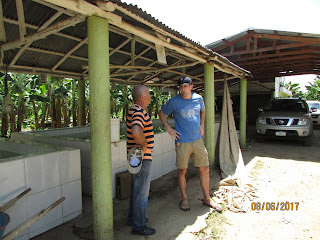Improving Soil management & Crop Diversification through Windbreaks
By F2F Volunteer Harry Greene
My name is Harry Greene, I live in Burlington, Vermont, and I am the co-founder of and head of farm development for Propagate Ventures. We are an investment management firm that links financial capital with agroforestry and multi-species agriculture. My role at Propagate involves creating replicable economic models for polyculture (biodiverse) agroforestry systems. In plain English: I design organic orchards that grow more than one type of fruit; I work with everything from building the soil, to planting the trees, to forecasting management requirements over a 10-year time horizon. I also work as part of team that manages a 245-acre organic farm in Shelburne, Vermont, where I run a chestnut-centric tree nursery and agroforestry consultancy called 100 Years of Sun, which is the nursery and installation arm of Propagate Ventures.
In February of 2017, Partners of the Americas’ Farmer to Farmer (F2F) program contacted me with the opportunity to travel to the Dominican Republic to develop a process for establishing windbreaks on banana plantations. The goal of my trip to the Dominican Republic was to develop an economically-viable windbreak installation procedure, and gain a better understanding of tropical agroforestry systems.
Banelino, Bananos Ecológicos de la Línea Noreste, is an association of banana farmers in the Dominican Republic. Since 1996, they have grown into a network of 334 member farms, 85% of which are certified organic. Their farmers are experiencing the effects of climate change first-hand. Strong, dry winds are damaging banana plants, and drastically reducing farm income. The planting of windbreaks –also known as shelterbelts, “barreras vivas” in Spanish, or simply rows of trees that are stronger than bananas– has thus far been unsuccessful. Farmers do not see non-fruiting species as contributing sufficient benefit as to outweigh the financial and temporal costs of having to deal with an additional feature on their landscape.
In order to shift the entrenched collective mindset that is a banana monoculture, I recommended that Banelino communicate the value of reduced wind-speeds in terms of dollars in lost yield, and simultaneously re-frame the planting of windbreaks as “growing additional tree crops.” The effectiveness of a windbreak is determined by its height and density, but the probability of farmers planting rows of additional species is dependent on cultural and financial inertia. Consequently, our windbreaks must manifest themselves in lime and avocado trees. Distribution channels for organic fruit are generally well established in the Dominican Republic, and adding a crop to the roster is far from unreasonable. The technical directors, extension agents, and farmers of Banelino were all in tune with this idea.
In addition to being multi-functional, windbreaks must also be profitable. We often focus too much on the revenue of an enterprise and not enough on its costs. The next step for Banelino is to map out the pro-forma income statements of fruiting windbreaks over ten years. If we work in good financial planning, the process of diversifying farm income by way of bio-diversifying farms will become self-perpetuating. These lime and avocado trees are given as possible species, because farmers are already growing these crops. However, in order to find the intersection between financial and physical feasibility, Banelino should also conduct an economic analysis of crops such as cacao, moringa, and dwarf coco palm. This process is multi-disciplinary and will require a diverse team of agronomy technicians, producers, and fruit exporters to make these windbreaks happen. Banelino is a very cohesive network, and I am confident that they will do good work.
On a more personal note, this experience was absolutely phenomenal. For me, life doesn’t get much better than combining agroforestry and Latin America. Seeing 20 farms in various parts of the Dominican Republic, and coming to understand tropical agroforestry systems has reaffirmed that exchanging stories, practices, and ideas is indispensable. Trees grow much faster in the tropics than they do in cold climates. In Vermont, even if one has a base in ecology, the forest is quieter than it is in the tropics, and it moves more slowly. In The Dominican Republic, I could (figuratively) see the trees growing, and ecological succession became as clear as day. Epiphanies sprung up left and right in regard to agroforestry and organic food production. Biodiversity as a concept grew much deeper roots. I see a very clear correlation between human health and the quantity of surrounding biomass. With the growth of the forest comes human prosperity. Plant the trees.







.png)

Comments
Post a Comment